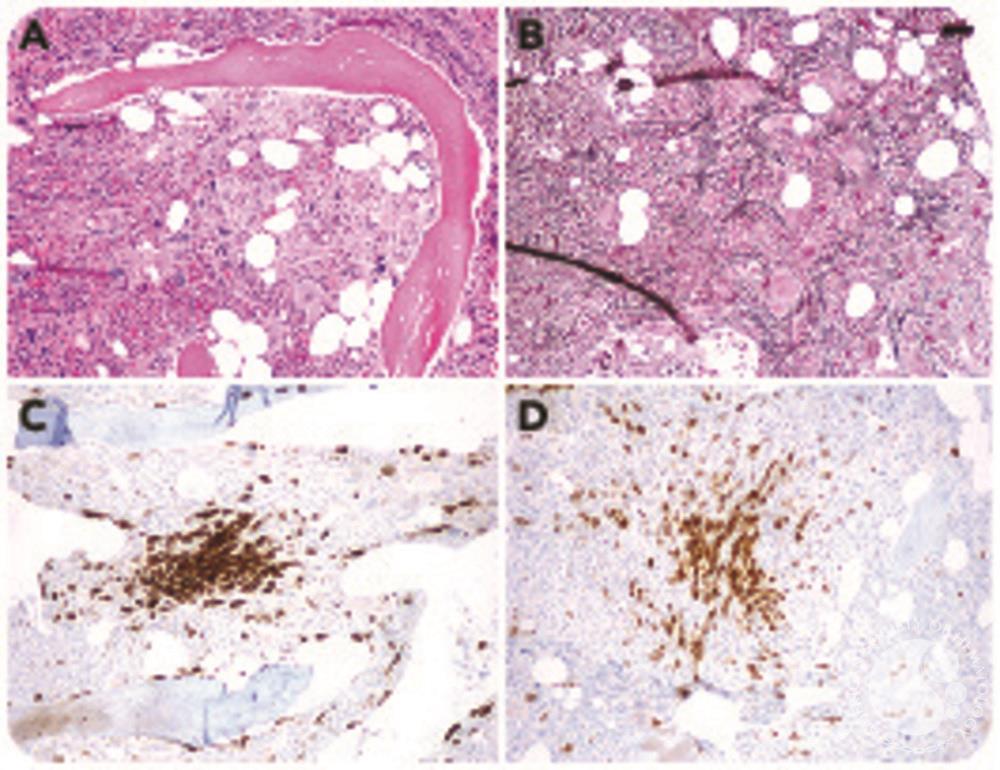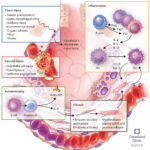Systemic mastocytosis with associated hematological neoplasm (SM-AHN) is a rare and complex condition where the proliferation of mast cells, typically observed in systemic mastocytosis (SM), occurs alongside a hematological neoplasm, such as leukemia or myelodysplastic syndromes. The coexistence of these two conditions leads to an intricate pathophysiology that requires careful diagnosis and management. This variant of systemic mastocytosis is associated with worse outcomes compared to the more typical forms of mastocytosis.

Key Characteristics of Systemic Mastocytosis with Associated Hematological Neoplasm
- Abnormal mast cell proliferation: Characterized by an increase in mast cells in various organs.
- Hematological neoplasm: The presence of blood cancers, such as leukemia or myeloproliferative disorders, complicates the condition.
- Poor prognosis: The combination of systemic mastocytosis and a hematological neoplasm leads to more severe complications and a poorer long-term prognosis.
Pathophysiology of Systemic Mastocytosis with Associated Hematological Neoplasm
Mast cells, which are a crucial component of the immune system, are typically involved in allergic reactions. In systemic mastocytosis, there is a mutation in the KIT gene, leading to the excessive growth of mast cells. However, in cases of systemic mastocytosis with associated hematological neoplasm, these abnormal mast cells coexist with a hematological malignancy, such as chronic eosinophilic leukemia or acute myelogenous leukemia.
The KIT gene mutation, which is present in many systemic mastocytosis cases, may play a role in both the mast cell proliferation and the development of the associated hematological neoplasm. In some instances, the hematological neoplasm may arise due to the progression of systemic mastocytosis, further complicating the clinical picture.
Symptoms of Systemic Mastocytosis with Associated Hematological Neoplasm
General Symptoms
Systemic mastocytosis with associated hematological neoplasm presents with a range of symptoms due to the abnormal proliferation of mast cells and the hematological malignancy. Common manifestations include:
- Skin lesions: These may appear as urticaria pigmentosa, with brownish, itchy patches on the skin. These lesions can often be aggravated by physical stimuli.
- Gastrointestinal issues: Many patients experience chronic abdominal pain, nausea, vomiting, and diarrhea due to mast cell activity in the gastrointestinal tract.
- Anaphylaxis: Severe allergic reactions due to excessive histamine release can cause anaphylactic shock, leading to difficulty breathing and a drop in blood pressure.
Hematological Neoplasm-Related Symptoms
The hematological neoplasm associated with systemic mastocytosis can lead to additional symptoms, such as:
- Fatigue and weakness: Resulting from anemia or the presence of leukemia.
- Bone pain: Bone marrow infiltration by mast cells and leukemia cells can cause significant discomfort and pain.
- Splenomegaly and hepatomegaly: Enlarged spleen and liver are common due to mast cell proliferation and hematological neoplasm involvement.
Other Complications
- Organ failure: Severe organ damage due to mast cell accumulation and the progression of the hematological neoplasm may result in organ failure, particularly in the liver, spleen, and bone marrow.
- Leukemic transformation: In some patients, the hematological neoplasm may evolve into acute leukemia, worsening the overall prognosis.
Diagnosis of Systemic Mastocytosis with Associated Hematological Neoplasm
Clinical Evaluation and History
The diagnosis of systemic mastocytosis with associated hematological neoplasm begins with a comprehensive clinical evaluation. A detailed patient history is essential, especially considering any previous diagnoses of hematological malignancies or systemic mastocytosis. Clinical suspicion is heightened in patients with unexplained skin lesions, gastrointestinal symptoms, and an abnormal blood count.
Diagnostic Tests
- Bone Marrow Biopsy: This is the most definitive diagnostic tool for systemic mastocytosis. A bone marrow biopsy will reveal the infiltration of mast cells along with any hematological neoplasm, such as leukemia cells.
- Serum Tryptase Levels: Elevated tryptase levels indicate mast cell activation and are useful in diagnosing systemic mastocytosis. However, these levels can also be elevated in patients with hematological neoplasms, complicating the interpretation.
- KIT Gene Mutation Testing: Identifying the KIT mutation in patients can confirm systemic mastocytosis. However, the presence of this mutation in patients with an associated hematological neoplasm may complicate the clinical management and prognosis.
- Peripheral Blood Smear: This test helps to identify abnormal cells in the blood, which may indicate the presence of a hematological malignancy, such as leukemia or myeloproliferative disorder.
- Imaging Studies: Imaging modalities such as ultrasound, CT scans, or MRI may be used to assess organ involvement, particularly in the spleen, liver, or bone marrow.
Treatment Strategies for Systemic Mastocytosis with Associated Hematological Neoplasm
First-Line Treatment: Symptom Management
The management of systemic mastocytosis with associated hematological neoplasm involves addressing both the mastocytosis-related symptoms and the hematological malignancy.
- Antihistamines: These are used to control allergic symptoms related to histamine release, such as itching, flushing, and gastrointestinal distress.
- Mast Cell Stabilizers: Cromolyn sodium and similar medications help to prevent mast cells from releasing histamine, thereby controlling symptoms.
Treatment for Hematological Neoplasm
- Chemotherapy: For patients with a hematological malignancy such as leukemia, chemotherapy is often the first-line treatment. This helps to reduce the number of malignant cells and control disease progression.
- Tyrosine Kinase Inhibitors (TKIs): For patients with systemic mastocytosis driven by a KIT mutation, TKIs such as midostaurin are commonly used to inhibit mast cell proliferation and reduce the risk of disease progression.
- Stem Cell Transplantation: In cases of aggressive hematological neoplasm or mast cell leukemia, stem cell transplantation may be considered to reset the bone marrow and reduce the abnormal cell growth.
Combination Therapies
In some cases, a combination of treatments may be necessary to manage both conditions. For example, chemotherapy for the hematological neoplasm may be combined with mast cell stabilization therapies to address the systemic mastocytosis symptoms.
Prognosis and Long-Term Outlook
Systemic mastocytosis with associated hematological neoplasm is a rare and complex condition that presents a more challenging prognosis compared to typical forms of systemic mastocytosis. The overall prognosis depends on several factors:
- Severity of the hematological neoplasm: If the hematological malignancy is aggressive, such as acute leukemia, the prognosis can be poor.
- Response to treatment: Early and aggressive treatment with chemotherapy and TKIs can improve outcomes, but the prognosis remains guarded, especially in advanced cases.
- Organ involvement: Severe organ damage from mast cell infiltration or leukemia can significantly impact the prognosis.
Life Expectancy and Management
With appropriate management, including symptom control and targeted therapies, many patients can live for years with systemic mastocytosis and an associated hematological neoplasm. However, close monitoring is essential, as both conditions have the potential to evolve and worsen over time.
Lifestyle and Monitoring for Systemic Mastocytosis with Hematological Neoplasm
Lifestyle Adjustments
Patients with systemic mastocytosis with associated hematological neoplasm should take proactive steps to manage their symptoms, including:
- Avoiding known triggers such as certain foods, allergens, or stressors.
- Maintaining a healthy lifestyle with a balanced diet and regular exercise to support overall health.
- Stress management techniques such as yoga, meditation, or counseling to reduce the risk of mast cell activation.
Regular Monitoring
Given the complexity of systemic mastocytosis with associated hematological neoplasm, regular follow-up is crucial. This includes:
- Routine blood tests to monitor for changes in blood cell counts and the progression of hematological neoplasm.
- Bone marrow biopsies to assess for further mast cell proliferation or leukemic transformation.
- Imaging studies to monitor organ health, particularly the spleen, liver, and bone marrow.
Systemic mastocytosis with associated hematological neoplasm is a rare but complex disorder that requires a comprehensive treatment approach. Early diagnosis, careful monitoring, and a combination of therapies are essential to managing the condition and improving the quality of life for affected patients. With ongoing research and advancements in treatment options, there is hope for improved outcomes in the future.

